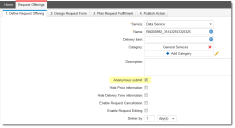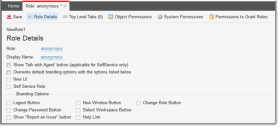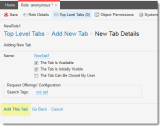Setting Up Anonymous Login
•About Knowledge Articles for Anonymous Users
•Setting Up Request Offerings for Anonymous Users
•Assigning the Anonymous User to the Role
•Accessing Service Manager using Anonymous Login
About Anonymous Login
You can allow any user to access specific records and information without requiring a login ID and password. Such users are called anonymous. For example, you can allow anonymous users to create specific request offerings or access certain Knowledge Base articles when they click a link from an email or web page.
This feature also enables you to open the Self-Service Portal to the outside world, permitting anyone the ability to create specific service requests.
About Knowledge Articles for Anonymous Users
Knowledge Base articles are read-only for anonymous users and do not require special set up procedures.
Setting Up Request Offerings for Anonymous Users
You must set up the request offerings to allow access to anonymous users.
1.Log in to the application as a service owner.
2.Open the Request Offering workspace.
3.Open the request offering to make available to anonymous users.
4.From the Define Request Offering page, check Anonymous submit.
Define Request Offering
5.From the Publish Action page, check Publish and Subscribe and choose an organizational unit.
Users see request offerings based on organizational units. For example, if you choose an organizational unit that includes everyone, then anonymous users see all request offerings, although they are only able to submit request offerings checked as Anonymous submit.
If anonymous users attempt to create a request offering to which they do not have access, they will have the option to log in as a registered user and continue with the request.
You can create an organizational unit only for anonymous use and select that unit here. Organizational units are restricted by role.
6.Click Save.
The request offering is ready for anonymous users.
Creating a Role
You must create an anonymous role, or designate one of your roles (such as Self Service or guests) as an anonymous user. Administrators can configure other roles (such as service owner) permission to create roles. See Working with Roles.
1.From the Configuration Console, click Configure > Users and Permissions > Roles and Permissions to open the Roles and Permissions workspace.
2.Create a new role. (See Working with Roles). Enter a unique user name (such as anonymous).
Create a New Role
3.Select Top Level Tabs.
4.Add the tabs for the user to have (such as Request Offering or Knowledge Self Service).
5.Check your options, then click Add This Tab.
Add This Tab
For the Knowledge tab, ensure that the Search Tags field is set to Knowledge .
Knowledge Tab
The application displays the tabs on the list.
6.Click Save.
Creating an Anonymous User
You must create an anonymous user.
1.Log into the Service Manager Application.
2.Open the Employee workspace.
3.Click New Employee. See Working with Employees.
4.Enter information into the required fields.
| Field | Description |
|---|---|
| First Name | The first name. Enter anonymous or another generic first name. |
| Last Name | The last name. Enter user or another generic last name. |
| Primary Email | The email address defined for anonymous users. Enter a valid email address. See Working with Email Inboxes. |
| Team | The team. Select from the drop-down list (such as Service Desk). This field is not important for this function. |
| Login ID | The login ID name. Enter anonymous. . Use this ID to configure the login link. |
5.Click Save.
Assigning the Anonymous User to the Role
You must assign your anonymous user to the role you created above.
1.From the Configuration Console, click Configure > Users and Permissions > Roles and Permissions to go to the Roles and Permissions workspace.
2.Click Find Users next to the anonymous role that you created. (See Creating a Role.) Anonymous users are allowed only one role.
3.Link the anonymous user to the role. See Linking Roles to an Employee. The anonymous user appears on the role list.
4.Click Save.
Accessing Service Manager using Anonymous Login
Users can access Service Manager from a link that you provide to them, such as in an email or on a web page.
Contact Ivanti Support to enable anonymous log in for your tenant. Provide the user ID to use for anonymous logins. Ivanti Support will configure your tenant to allow anonymous logins.
Give the URL to users to access the data. The URL is your tenant URL plus alp.aspx. For example, http://organization.saasit.com/alp.aspx. This link can be to the Request Offering workspace or to a specific Knowledge Base article.
When a user accesses the URL, the application takes them immediately to the record and they do not see the login page.


